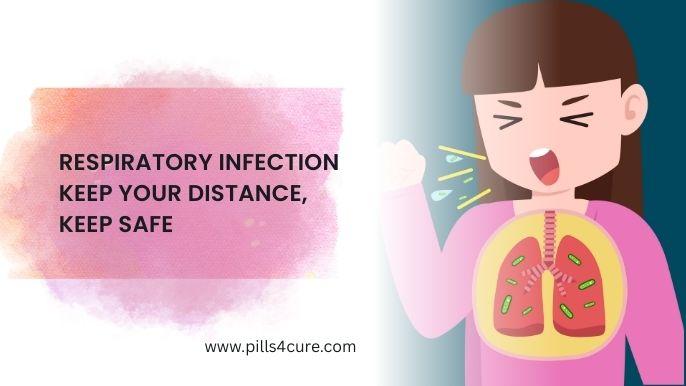Lower Respiratory Infection and Pneumonia: Key Health Insights

Lower respiratory tract infections (LRTIs) are a major health concern, impacting millions of Americans every year. Unlike upper respiratory infections that affect the nose, throat, and sinuses, LRTIs specifically target the lungs, bronchi, and bronchioles the essential structures responsible for oxygen exchange. Understanding lower respiratory infection symptoms and causes is key for early diagnosis, effective treatment, and the prevention of serious complications. This comprehensive guide covers everything from the basic meaning of lower respiratory infections to advanced treatment approaches, including how antibiotics like the ciprofloxacin pill may be used in certain cases to help fight bacterial causes. Whether you’re managing symptoms yourself, caring for a loved one, or expanding your medical knowledge, this resource offers clear, evidence-based insights to handle LRTIs with confidence.
What is Lower Respiratory Tract Infection (LRTI)?
Defining Lower Respiratory Tract Infection
Lower respiratory tract infection occurs when harmful microorganisms—including bacteria, viruses, fungi, or other pathogens—invade and multiply within the lower respiratory system. This system comprises:
- Trachea (windpipe)
- Bronchi (main airways branching from the trachea)
- Bronchioles (smaller airway branches)
- Alveoli (tiny air sacs where gas exchange occurs)
The Lower Respiratory Infection Meaning Explained
The lower respiratory infection meaning encompasses a spectrum of conditions ranging from acute bronchitis to severe pneumonia. Unlike common colds that affect upper respiratory structures, LRTI infection penetrates deeper into lung tissue, potentially causing more severe symptoms and requiring specialized medical attention.
These infections can be classified as:
- Community-acquired: Contracted outside healthcare settings
- Hospital-acquired: Developed during hospitalization
- Ventilator-associated: Occurring in mechanically ventilated patients
Types of Lower Respiratory Tract Infections
Acute Bronchitis
Often called a "chest cold," acute bronchitis involves inflammation of the bronchial tubes. While typically viral in nature, bacterial bronchitis may require antibiotic intervention.
Pneumonia
Pneumonia represents the most serious form of lower respiratory tract illness, characterized by infection and inflammation of lung tissue. It can be bacterial, viral, fungal, or caused by other microorganisms.
Bronchiolitis
Primarily affecting infants and young children, bronchiolitis involves inflammation of the smallest airways (bronchioles), commonly caused by respiratory syncytial virus (RSV).
Chronic Obstructive Pulmonary Disease (COPD) Exacerbations
Patients with existing COPD may experience acute worsening due to respiratory infection lower tract involvement, requiring immediate medical intervention.
Recognizing Symptoms of Lower Respiratory Infections
Primary Symptoms
- Persistent cough (may produce phlegm or blood)
- Difficulty breathing or shortness of breath
- Chest pain that worsens with breathing or coughing
- Fever and chills
- Fatigue and weakness
- Rapid or shallow breathing
Advanced Warning Signs
- High fever (above 101.3°F or 38.5°C)
- Severe chest pain
- Coughing up blood
- Bluish lips or fingernails (cyanosis)
- Confusion or altered mental state
- Severe breathing difficulties
Seek immediate medical attention if you experience any advanced warning signs, as these may indicate serious complications requiring emergency care.
Comprehensive Precautions and Prevention Strategies
Personal Hygiene Measures
- Frequent handwashing: Use soap and water for at least 20 seconds
- Alcohol-based sanitizers: When soap isn't available, use 60% alcohol content
- Avoid touching face: Prevent pathogen transfer from contaminated surfaces
- Respiratory etiquette: Cover coughs and sneezes with tissues or your elbow
Lifestyle Modifications
- Smoking cessation: Tobacco damages respiratory defenses significantly
- Regular exercise: Strengthens immune system and lung function
- Balanced nutrition: Supports immune system with essential vitamins and minerals
- Adequate sleep: 7-9 hours nightly for optimal immune function
- Stress management: Chronic stress weakens immune responses
Environmental Precautions
- Air quality awareness: Monitor pollution levels and stay indoors during poor air quality days
- Indoor air quality: Use air purifiers and maintain proper ventilation
- Avoid crowded spaces: Especially during flu season or respiratory illness outbreaks
- Workplace safety: Use appropriate protective equipment in high-risk environments
Vaccination Strategies
- Annual influenza vaccine: Reduces risk of viral pneumonia
- Pneumococcal vaccine: Protects against bacterial pneumonia
- COVID-19 vaccination: Prevents severe respiratory complications
- Pertussis (whooping cough) vaccine: Particularly important for vulnerable populations
Lower Respiratory Tract Infection Treatment Approaches
Medical Evaluation Process
Professional lower respiratory tract infection treatment begins with comprehensive evaluation including:
- Physical examination with chest auscultation
- Chest X-rays to visualize lung involvement
- Laboratory tests including complete blood count
- Sputum cultures when indicated
- Pulse oximetry to assess oxygen levels
Treatment Modalities
Viral Infections
Most viral LRTI infections are managed supportively with:
- Rest and adequate fluid intake
- Over-the-counter pain relievers for comfort
- Humidified air to ease breathing
- Monitoring for complications
Bacterial Infections
Bacterial lower respiratory tract infections require targeted antibiotic therapy based on:
- Pathogen identification through cultures
- Local resistance patterns
- Patient allergies and medical history
- Severity of infection
Supportive Care Measures
- Oxygen therapy: For patients with low oxygen levels
- Bronchodilators: To open airways and improve breathing
- Corticosteroids: For severe inflammation in specific cases
- Chest physiotherapy: To help clear respiratory secretions
Lower Respiratory Infection Antibiotics: A Detailed Overview
When Antibiotics Are Necessary
Lower respiratory infection antibiotics are prescribed when bacterial involvement is confirmed or highly suspected. Key indicators include:
- High fever with productive cough
- Elevated white blood cell count
- Positive bacterial cultures
- Clinical deterioration despite supportive care
Common Antibiotic Classes
- Beta-lactams: Including penicillins and cephalosporins
- Macrolides: Such as azithromycin and clarithromycin
- Fluoroquinolones: Including ciprofloxacin and levofloxacin
- Tetracyclines: Like doxycycline for specific pathogens
Antibiotic Selection Criteria
Healthcare providers consider multiple factors:
- Suspected or confirmed pathogen
- Local resistance patterns
- Patient's medical history and allergies
- Severity of infection
- Risk of complications
Ciprofloxacin: Comprehensive Antibiotic Profile
Ciprofloxacin Antibiotics Uses
Ciprofloxacin antibiotics uses extend beyond respiratory infections to include:
- Complicated urinary tract infections
- Certain skin and soft tissue infections
- Gastrointestinal infections caused by susceptible bacteria
- Bone and joint infections
- Specific cases of pneumonia, particularly hospital-acquired
Ciprofloxacin Tablet and Pill Formulations
Ciprofloxacin Tablet Specifications
- Available strengths: 250mg, 500mg, and 750mg
- Extended-release formulations for specific conditions
- Film-coated for improved palatability
- Scored tablets for dose flexibility when appropriate
Ciprofloxacin Pill Administration Guidelines
The ciprofloxacin pill should be:
- Taken with a full glass of water
- Administered on an empty stomach when possible
- Separated from calcium, magnesium, or iron supplements by at least 2 hours
- Taken at evenly spaced intervals to maintain consistent blood levels
Mechanism of Action
Ciprofloxacin works by inhibiting bacterial DNA gyrase and topoisomerase IV, essential enzymes for bacterial DNA replication and repair. This mechanism makes it effective against a broad spectrum of gram-positive and gram-negative bacteria.
Important Considerations for Ciprofloxacin Use
- Drug interactions: May interact with warfarin, theophylline, and other medications
- Side effects: Can include nausea, diarrhea, dizziness, and rarely, tendon problems
- Contraindications: Not recommended for children, pregnant women, or patients with certain medical conditions
- Resistance concerns: Should be used judiciously to preserve effectiveness
Risk Factors and Vulnerable Populations
High-Risk Groups
- Adults over 65: Weakened immune systems and underlying conditions
- Infants and young children: Immature immune systems
- Immunocompromised individuals: Including cancer patients and organ transplant recipients
- Chronic disease patients: Those with diabetes, heart disease, or lung conditions
- Healthcare workers: Increased exposure to respiratory pathogens
Occupational Risk Factors
- Healthcare settings exposure
- Industrial environments with poor air quality
- Agricultural work with organic dust exposure
- Military personnel in crowded quarters
- School and daycare workers
Lifestyle Risk Factors
- Smoking and secondhand smoke exposure
- Excessive alcohol consumption
- Poor nutritional status
- Sedentary lifestyle
- Chronic stress
Complications and When to Seek Emergency Care
Potential Complications
- Respiratory failure: Requiring mechanical ventilation
- Sepsis: Systemic infection spreading throughout the body
- Pleural effusion: Fluid accumulation around the lungs
- Lung abscess: Pus-filled cavity within lung tissue
- Acute respiratory distress syndrome (ARDS)
Emergency Warning Signs
Seek immediate medical attention for:
- Severe breathing difficulties
- Chest pain with breathing
- High fever with confusion
- Cyanosis (blue coloration of lips or fingernails)
- Coughing up significant amounts of blood
- Inability to maintain adequate fluid intake
Frequently Asked Questions (FAQs)
Q1: How long does a lower respiratory tract infection typically last?
A: The duration varies significantly depending on the type and severity of infection. Viral LRTI infections typically resolve within 7-10 days with supportive care, while bacterial pneumonia may require 1-2 weeks of treatment. Complete recovery, including return to normal energy levels, may take several weeks.
Q2: Can lower respiratory infections be contagious?
A: Yes, many lower respiratory tract infections are contagious, particularly those caused by viruses or bacteria like influenza, RSV, or tuberculosis. However, contagiousness varies by pathogen and individual factors. Practice good respiratory hygiene and follow isolation guidelines when recommended.
Q3: Is it safe to exercise with a lower respiratory infection?
A: Generally, avoid strenuous exercise during active lower respiratory tract illness. Light activities may be acceptable if symptoms are mild and above the chest, but always consult your healthcare provider. Resume normal exercise gradually as symptoms improve and energy levels return.
Q4: How can I differentiate between upper and lower respiratory infections?
A: Upper respiratory infections typically involve runny nose, sneezing, sore throat, and nasal congestion. Lower respiratory tract infections primarily cause cough, chest pain, difficulty breathing, and may include fever. However, some infections can affect both areas simultaneously.
Q5: When should I take antibiotics for a respiratory infection?
A: Lower respiratory infection antibiotics are only effective against bacterial infections and should be prescribed by a healthcare provider after proper evaluation. Never self-medicate with antibiotics, as inappropriate use contributes to antibiotic resistance and may cause side effects.








